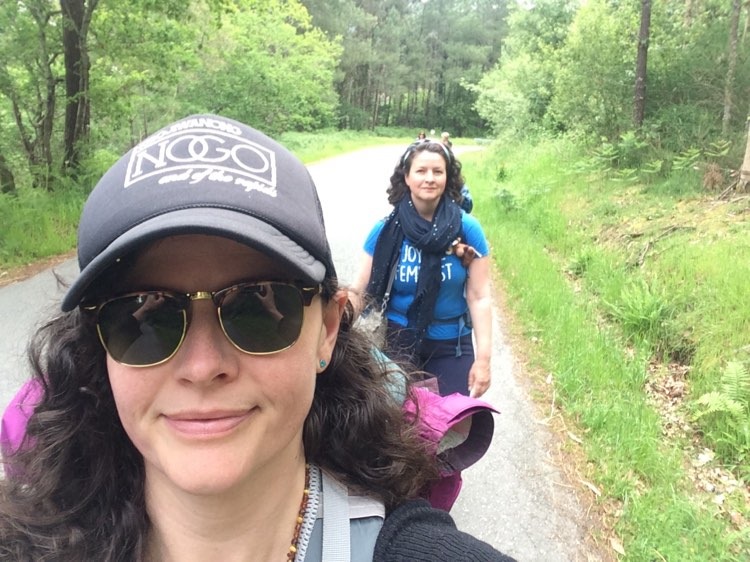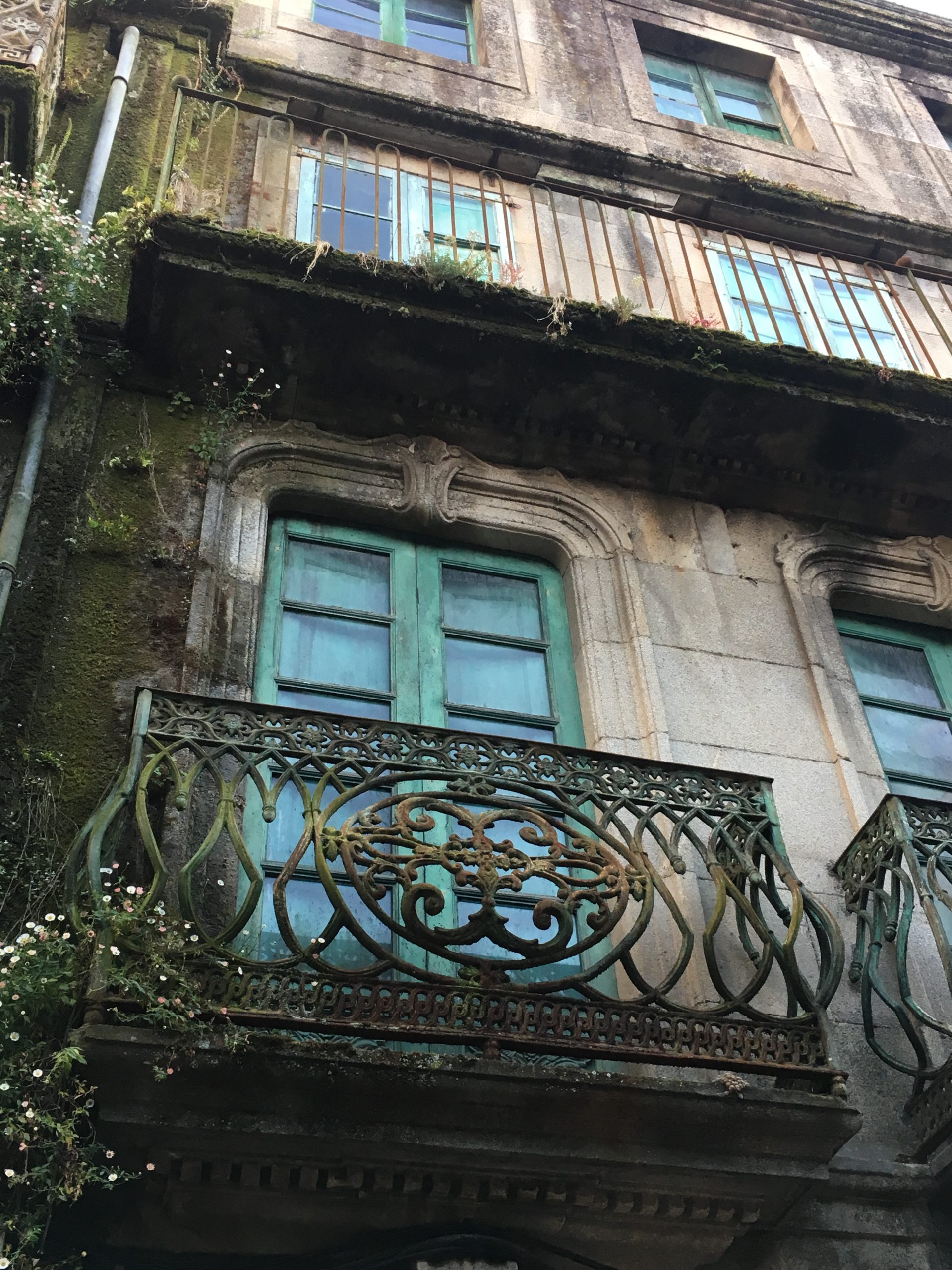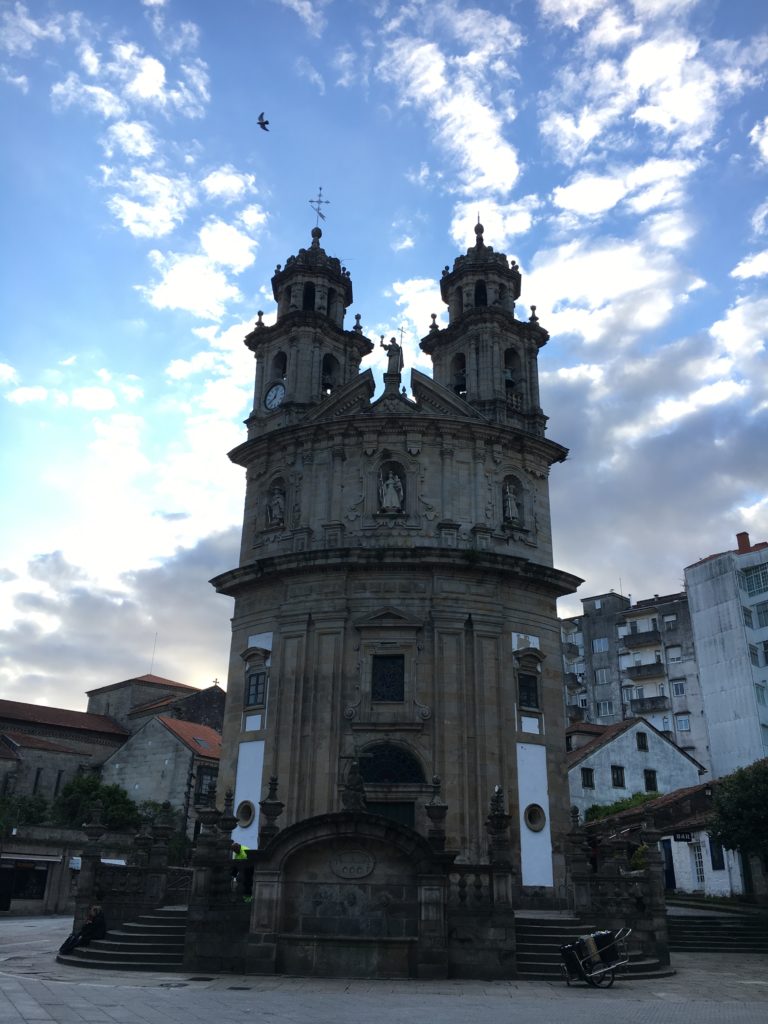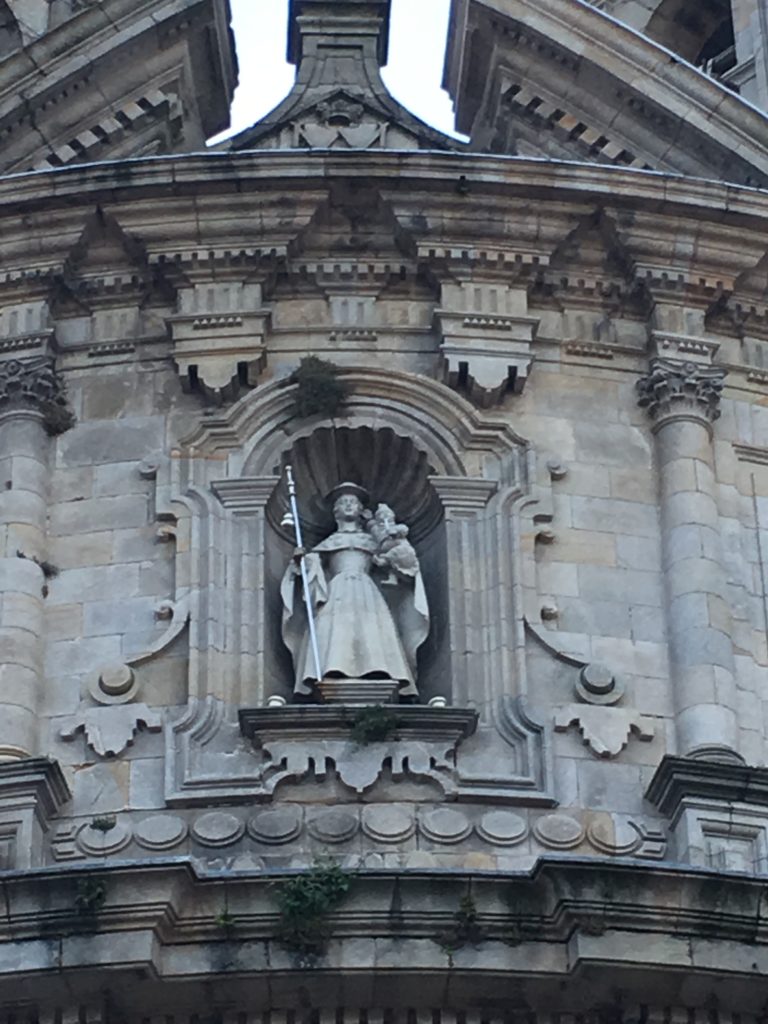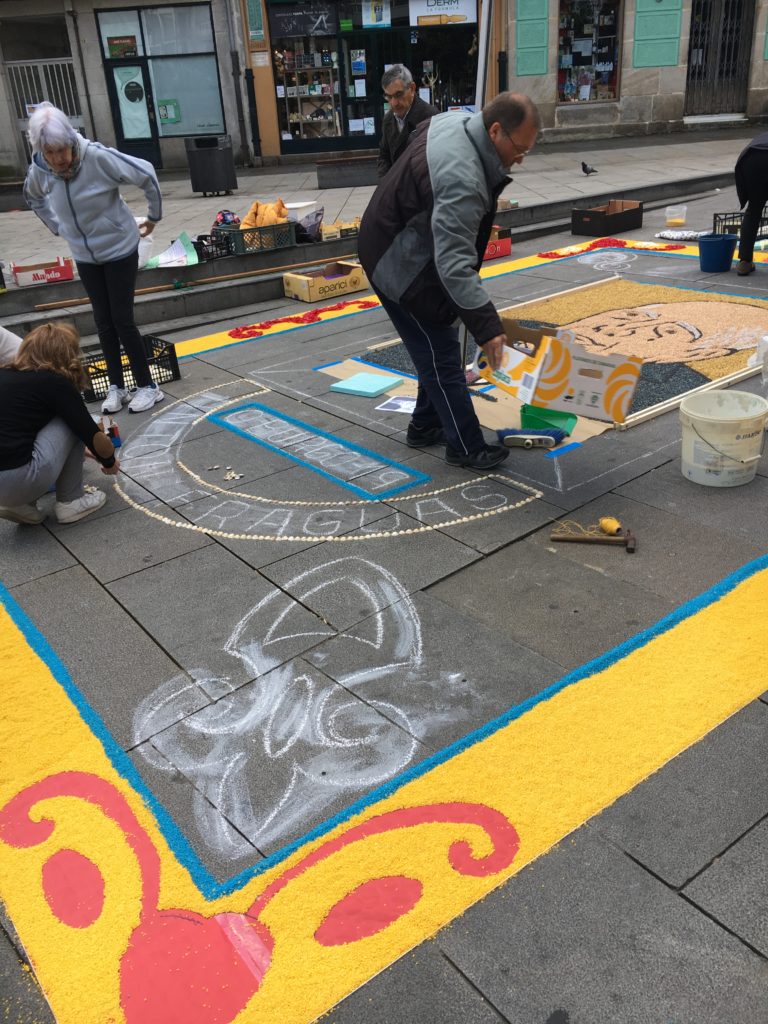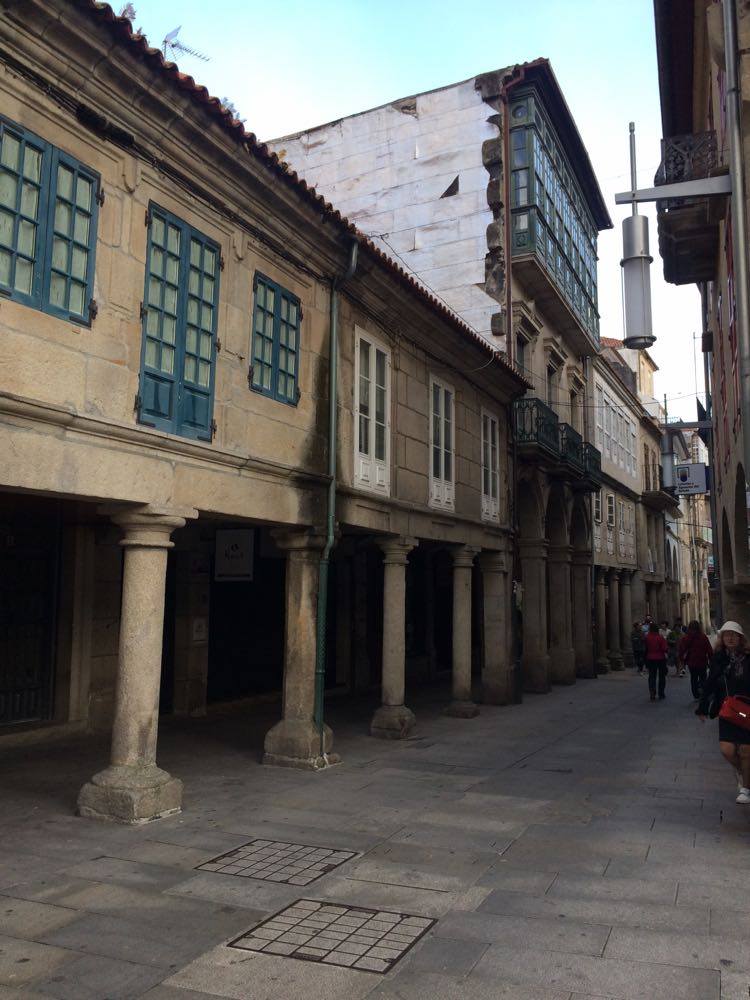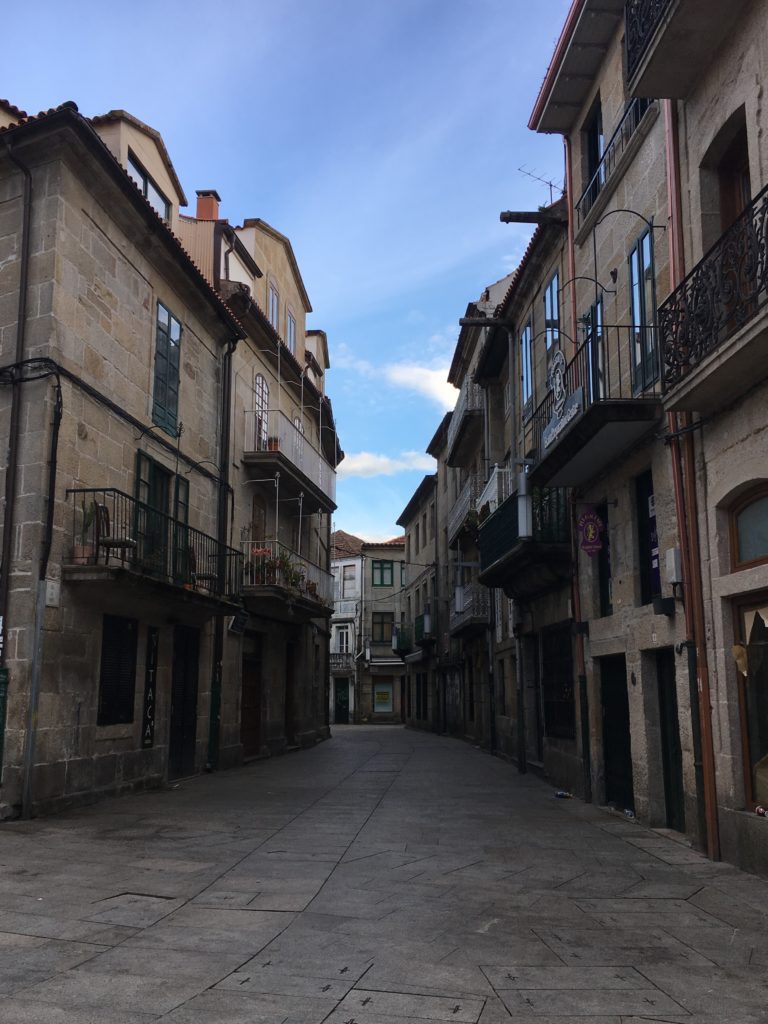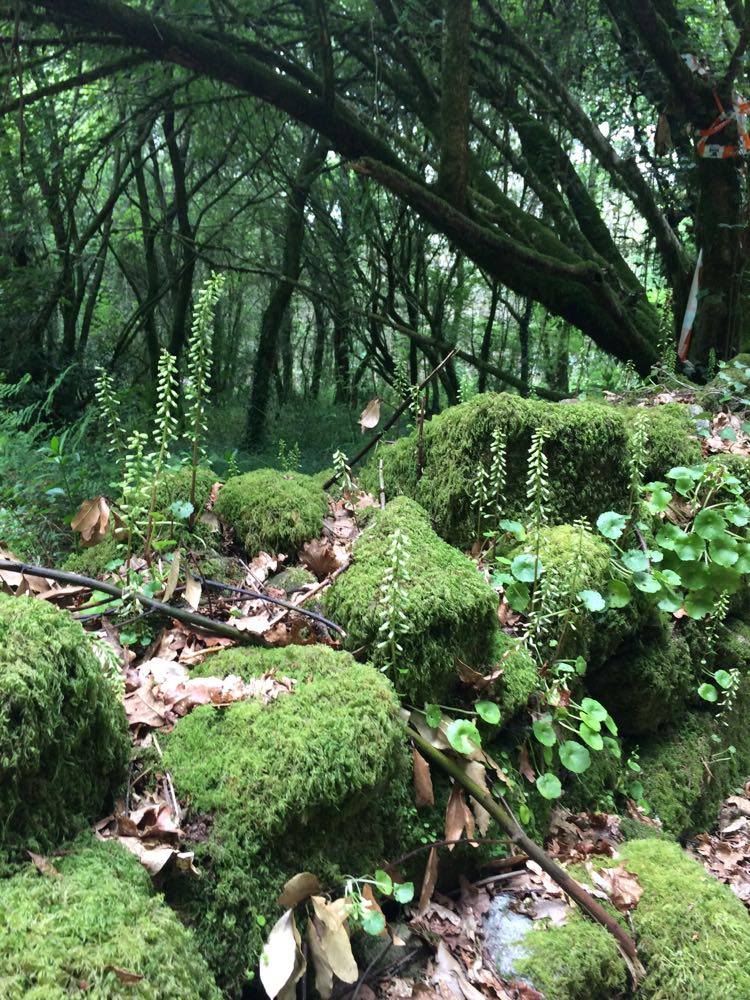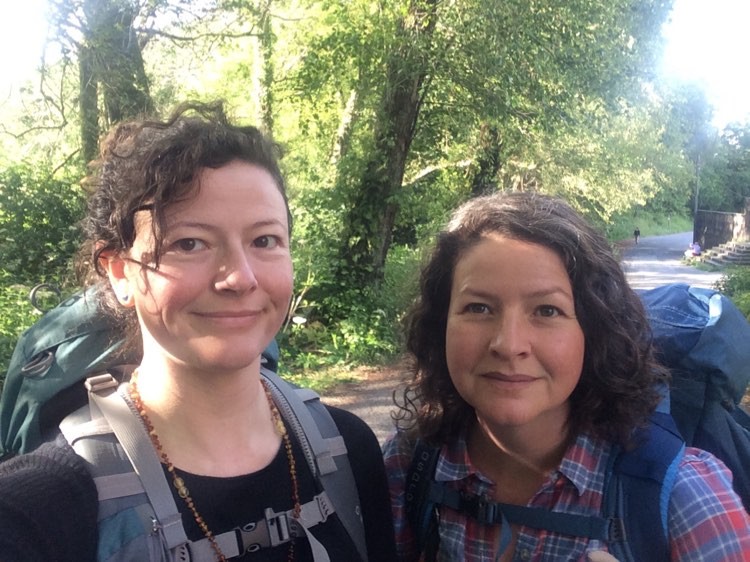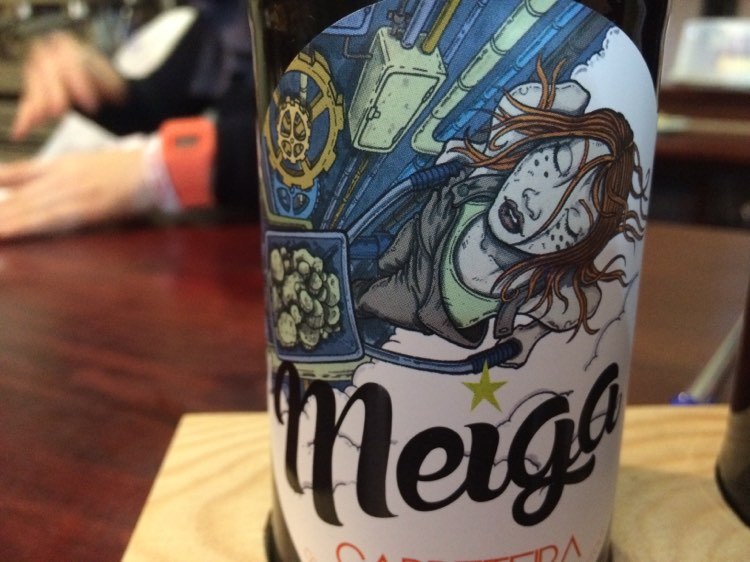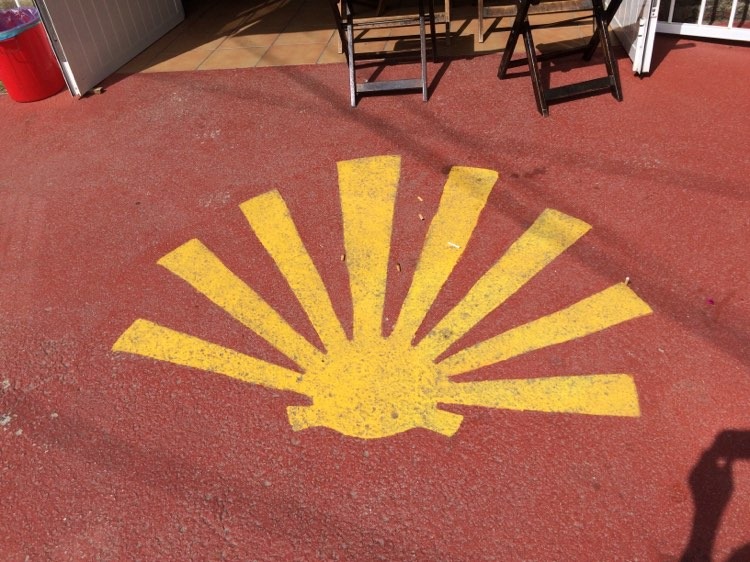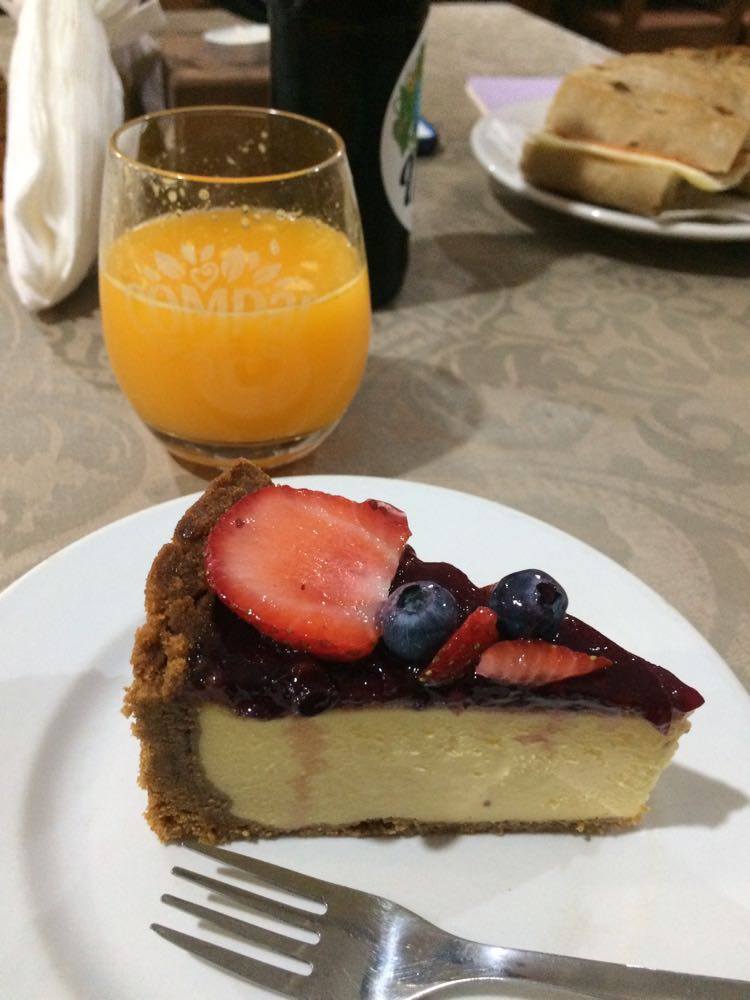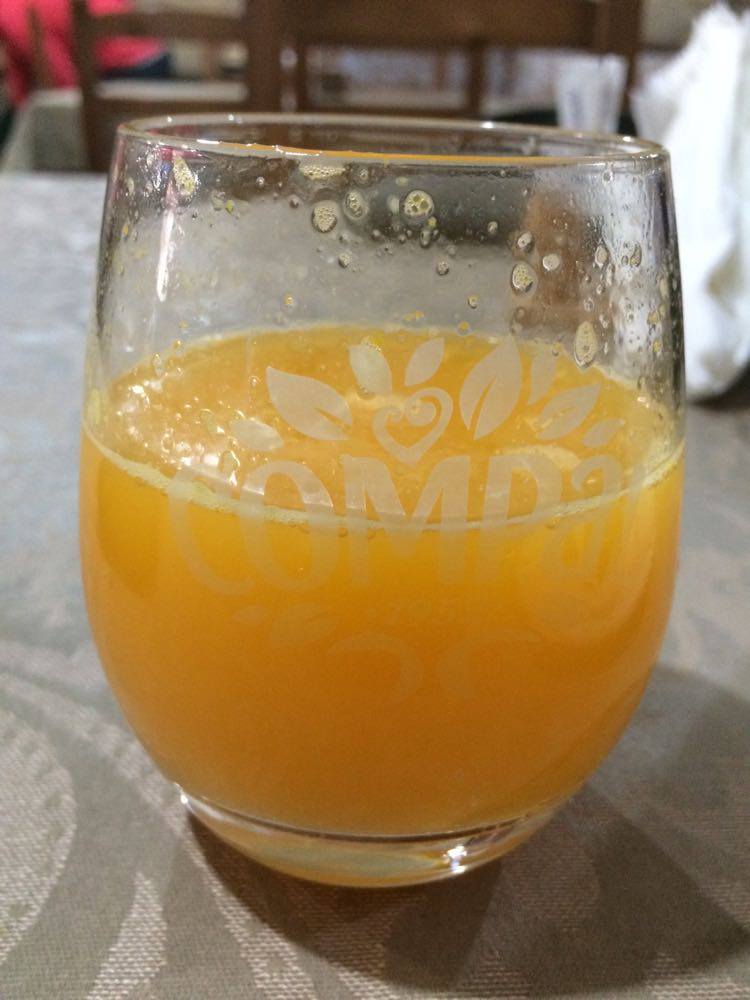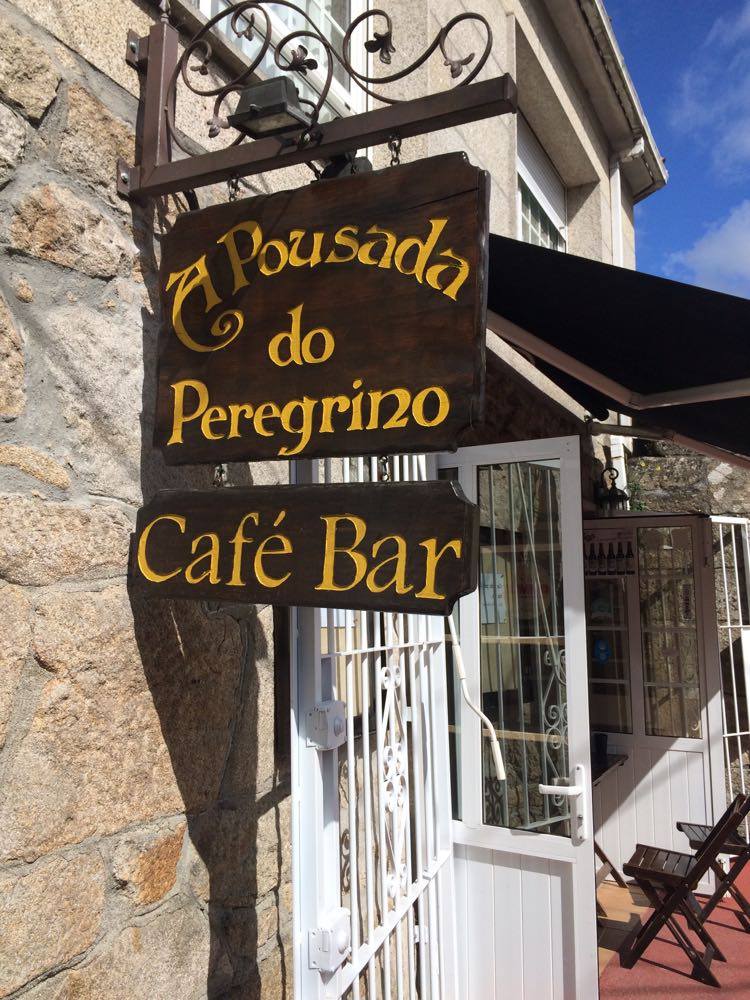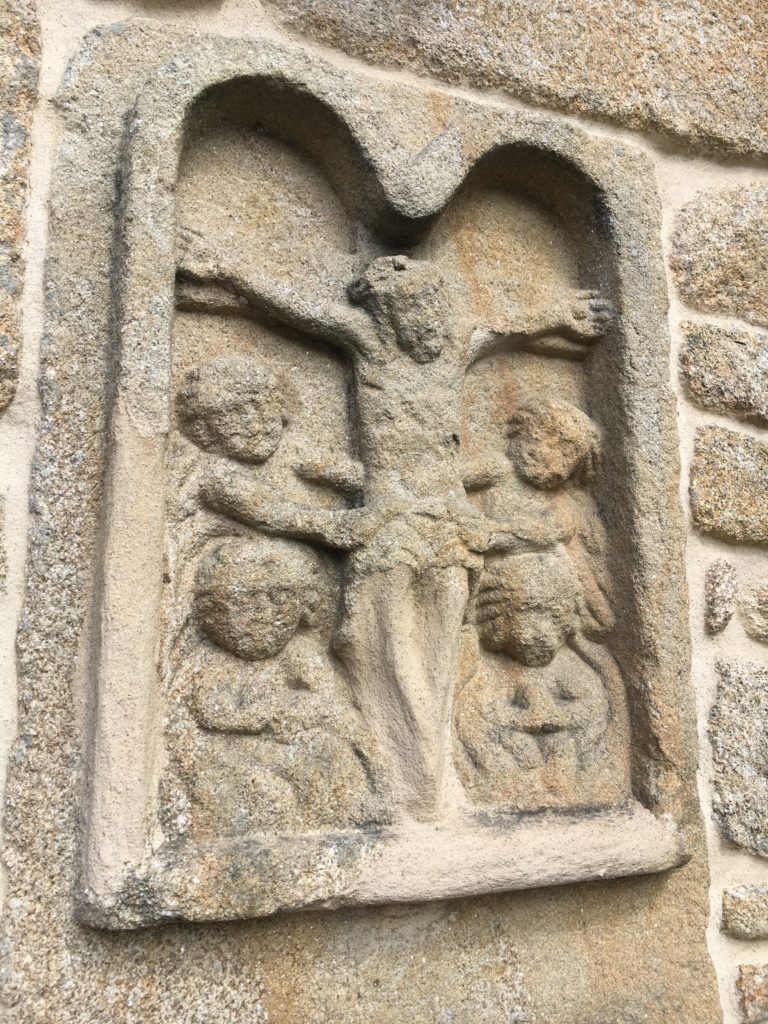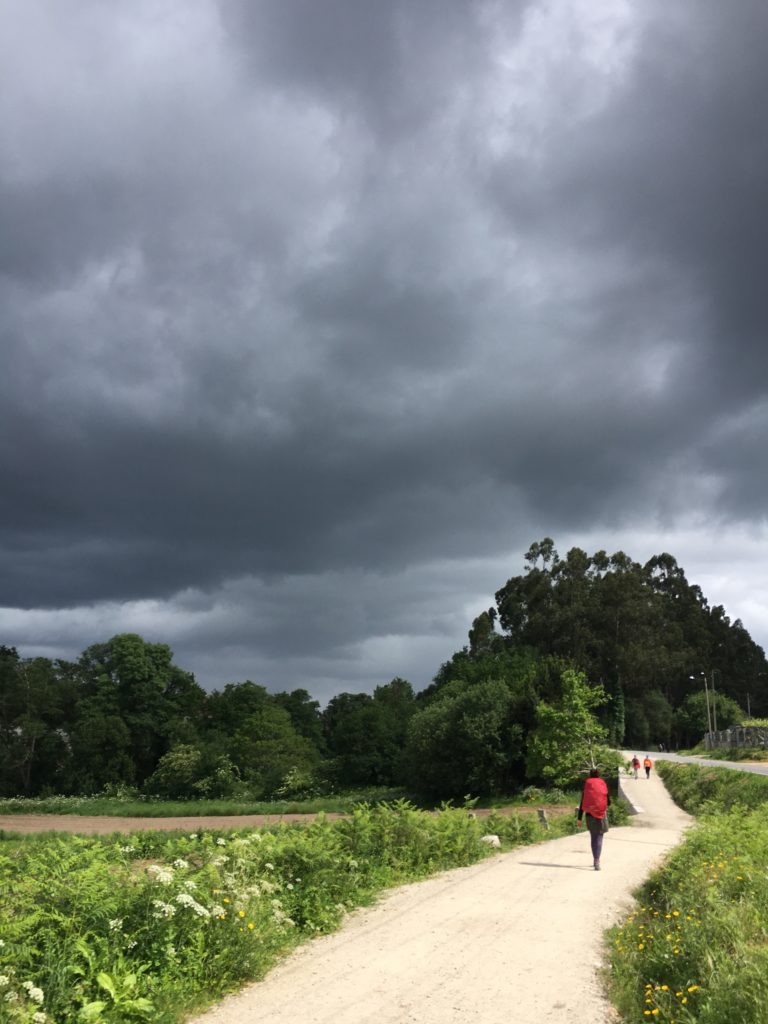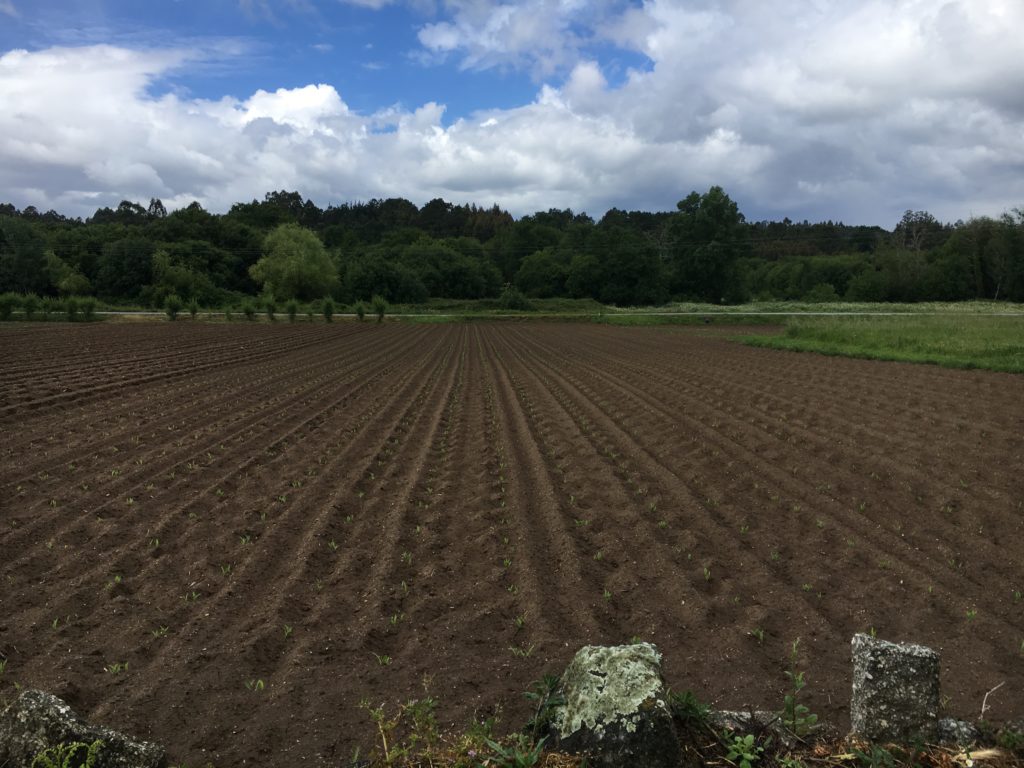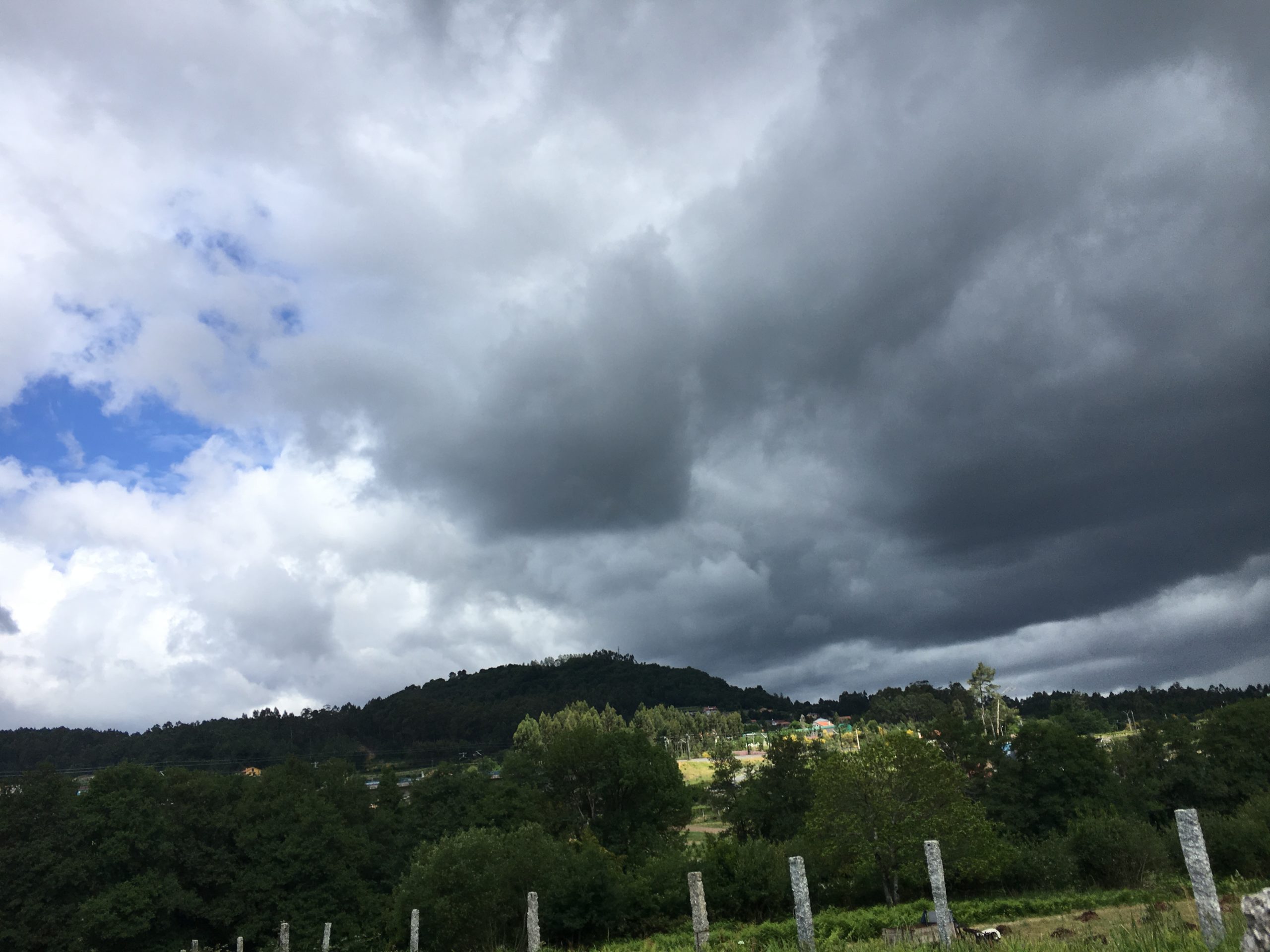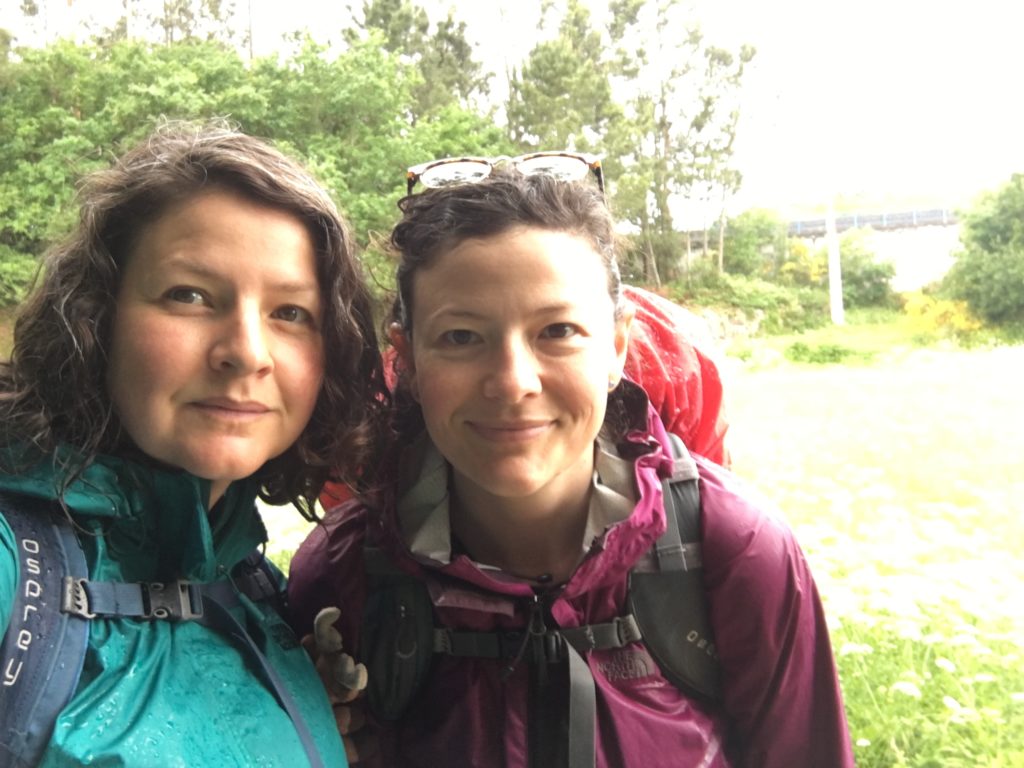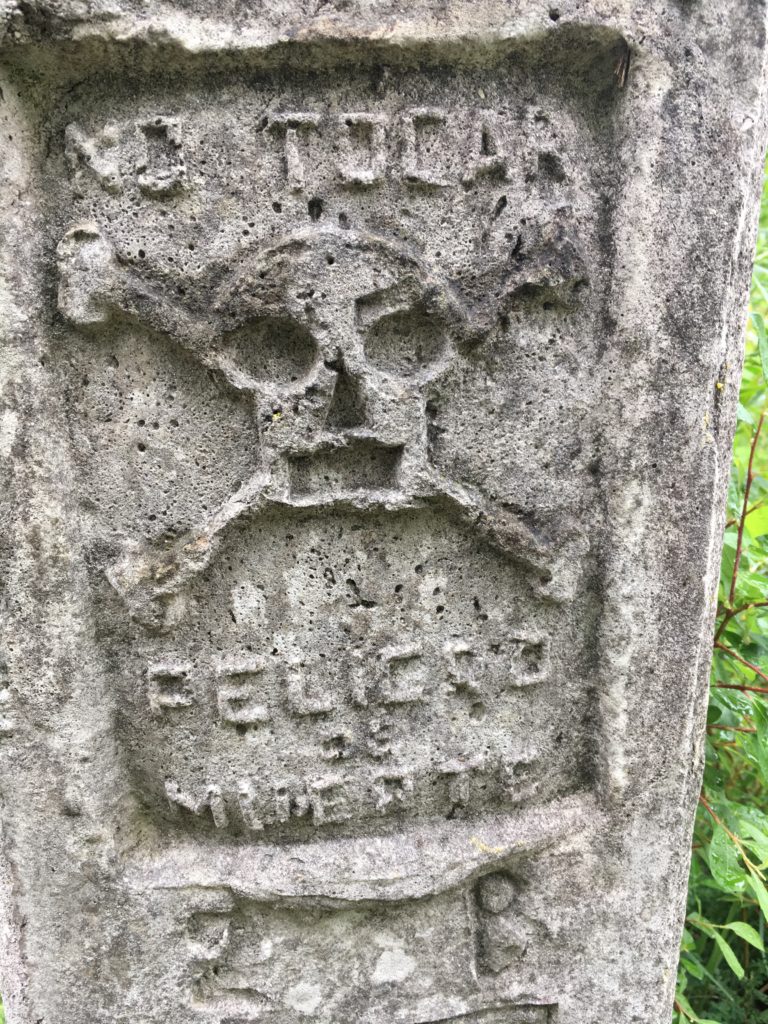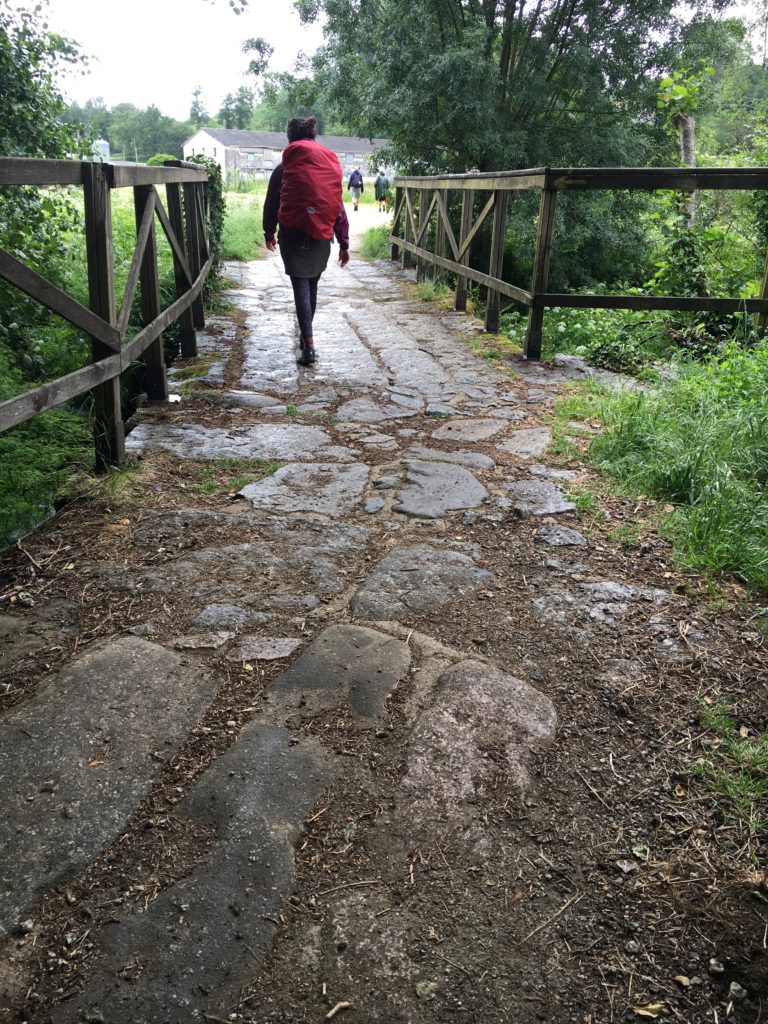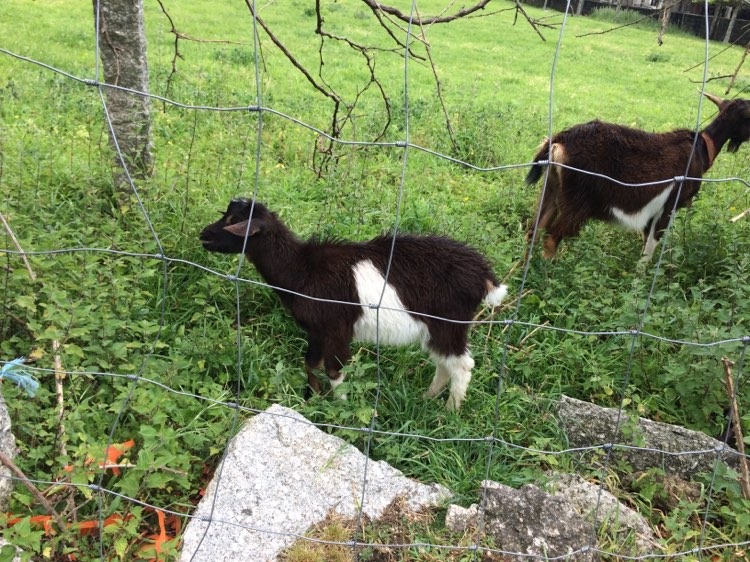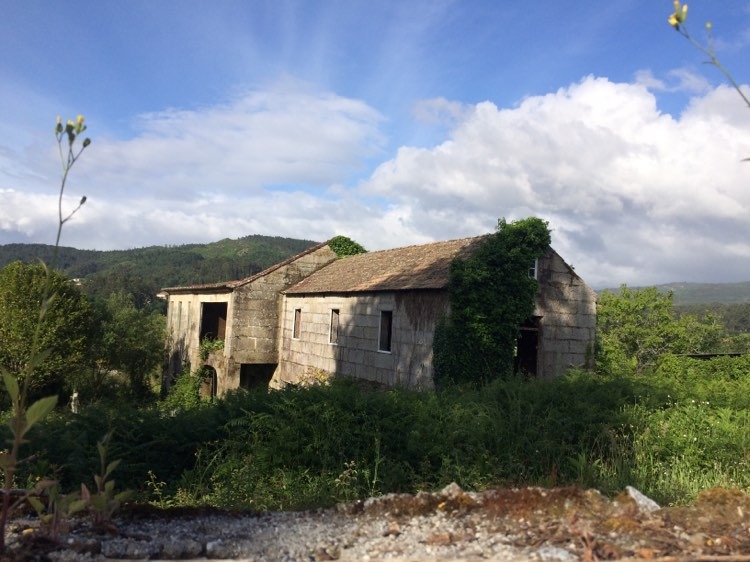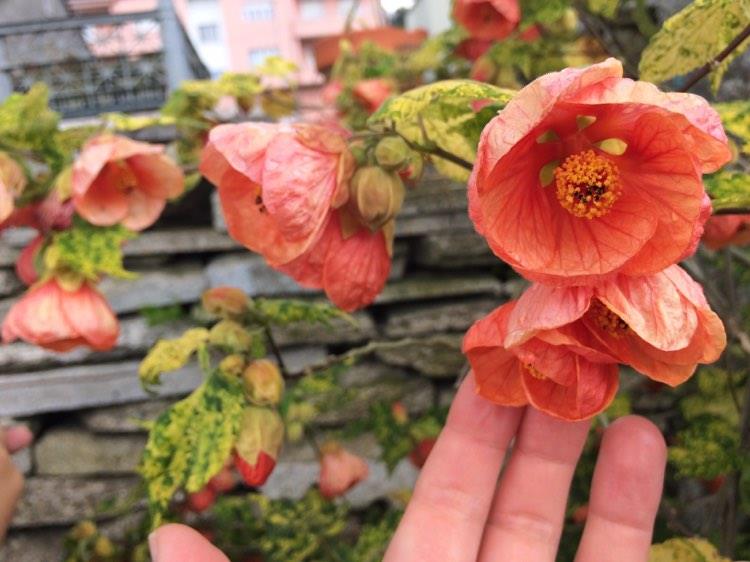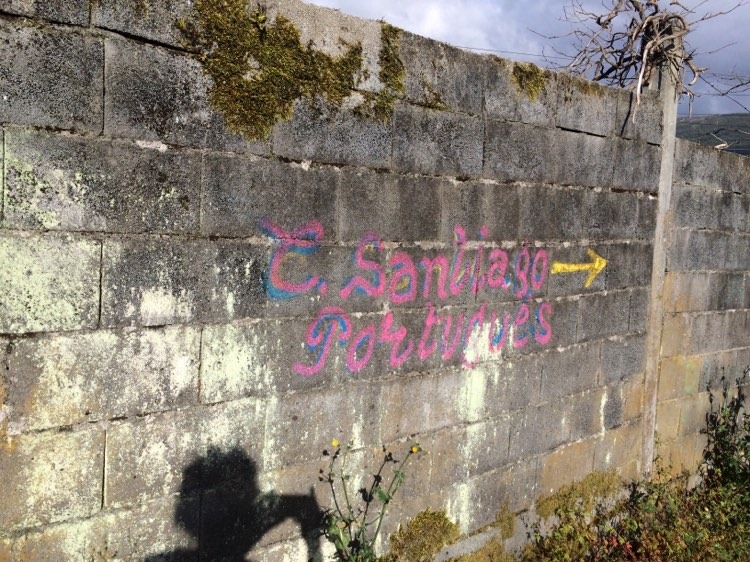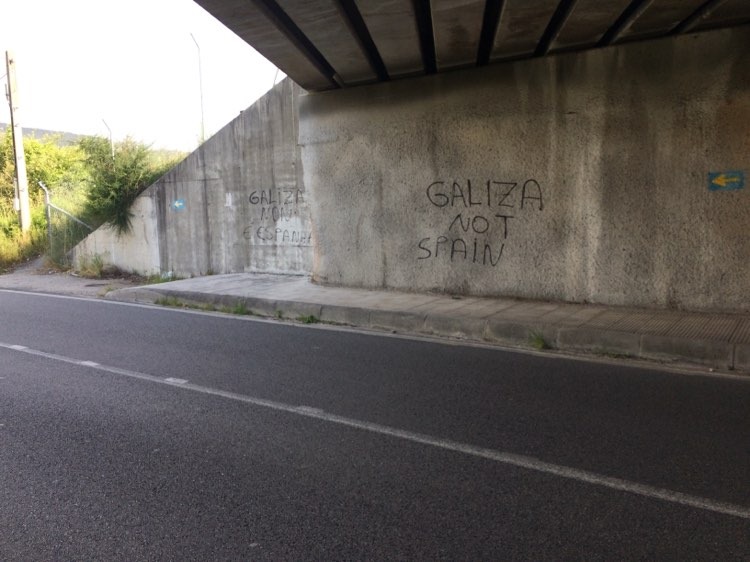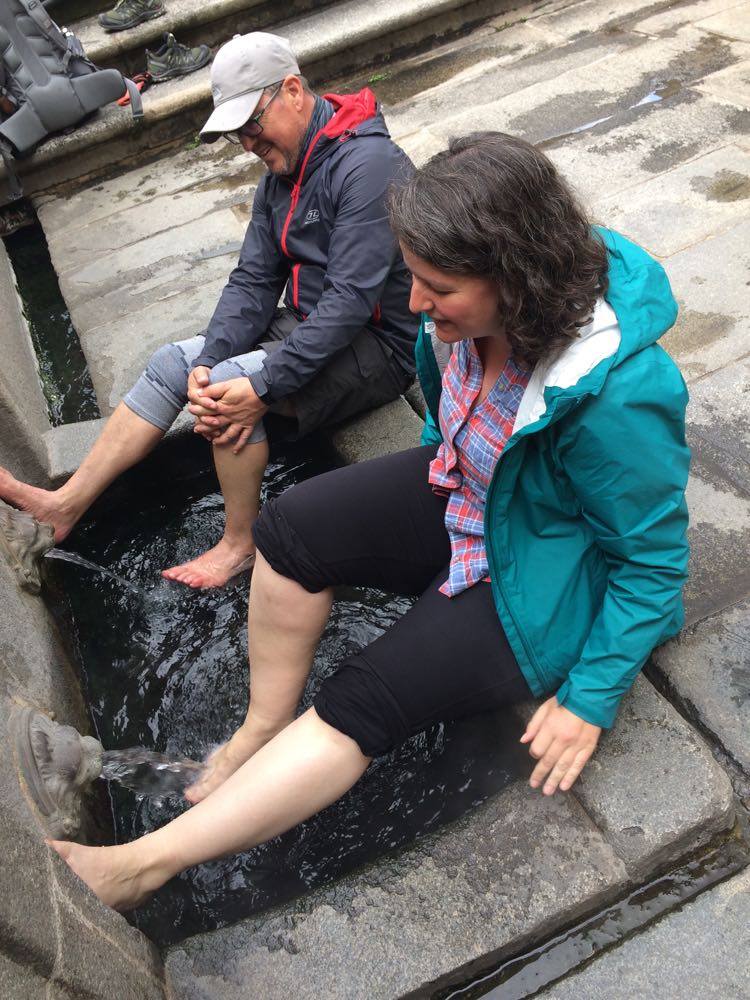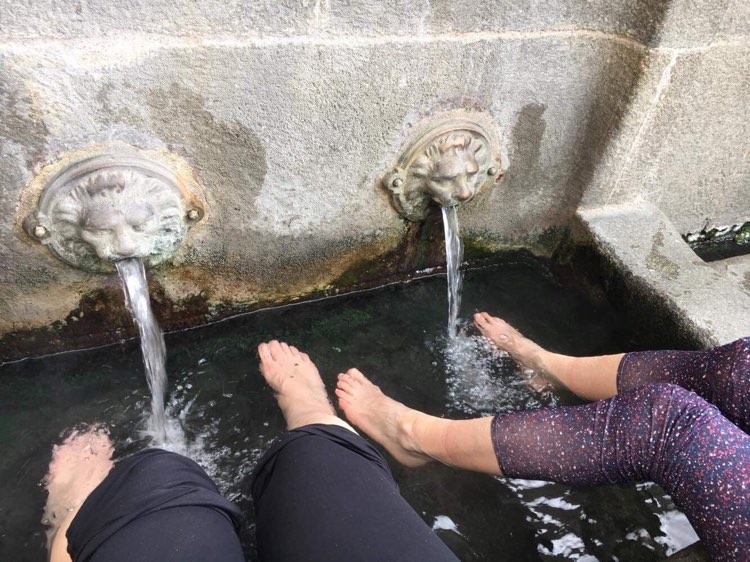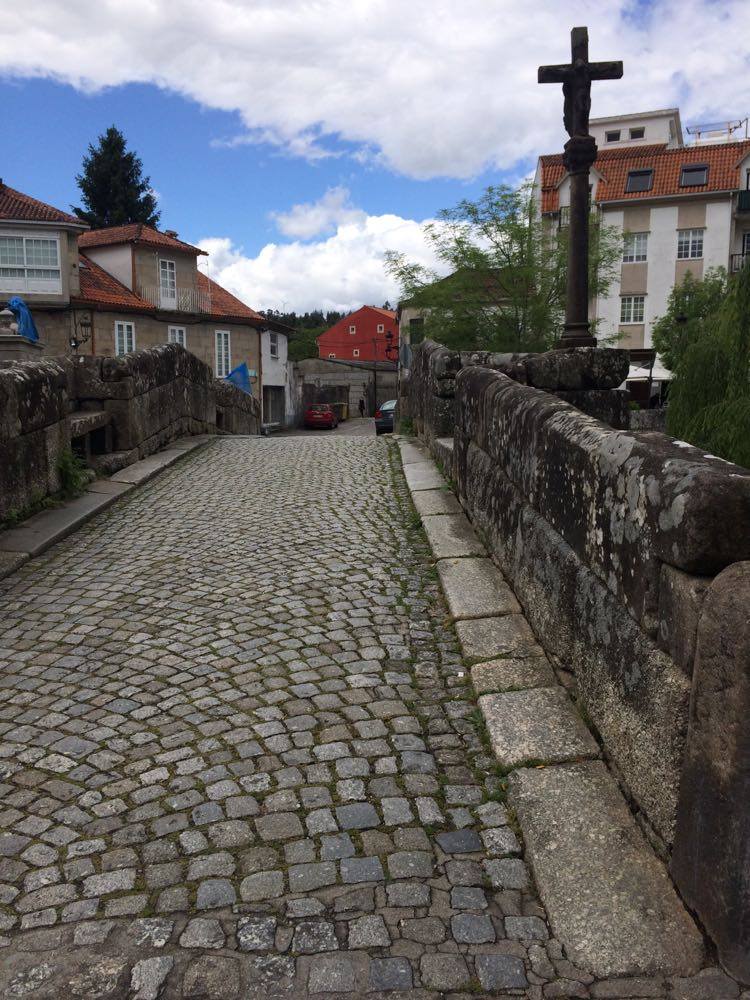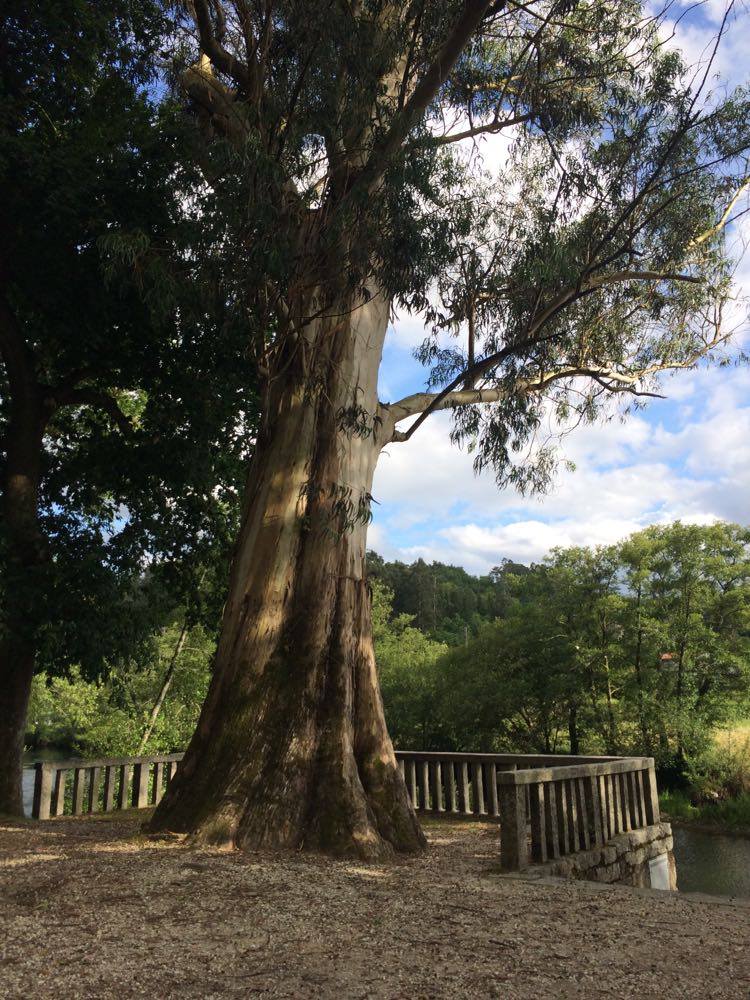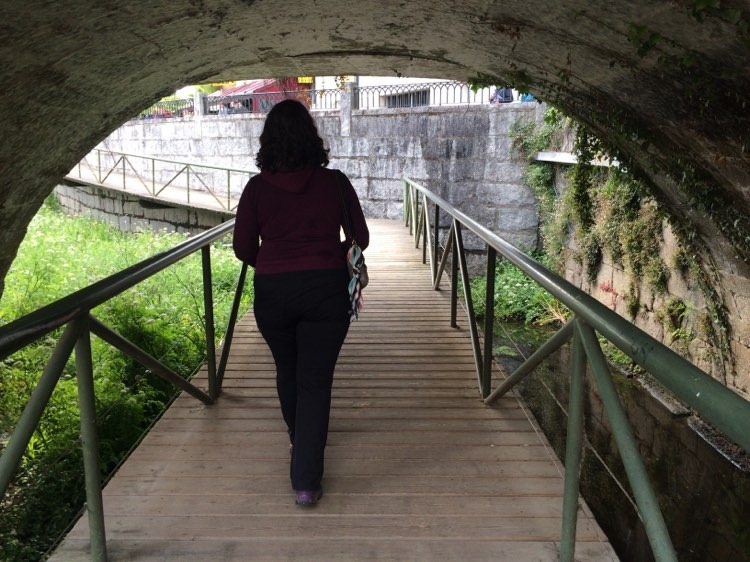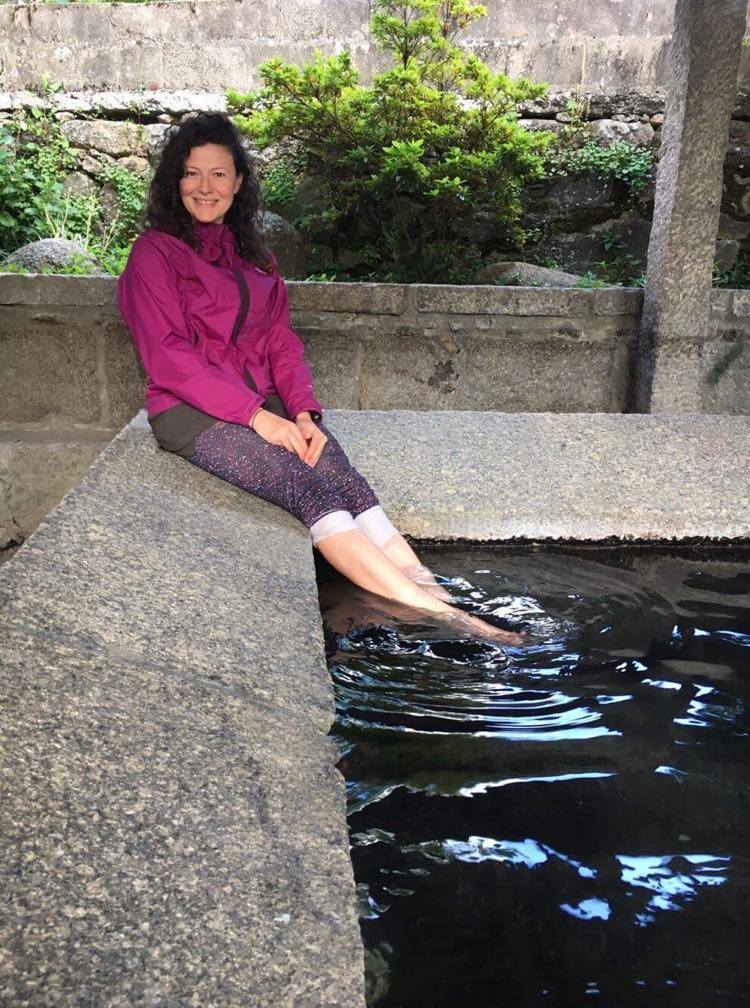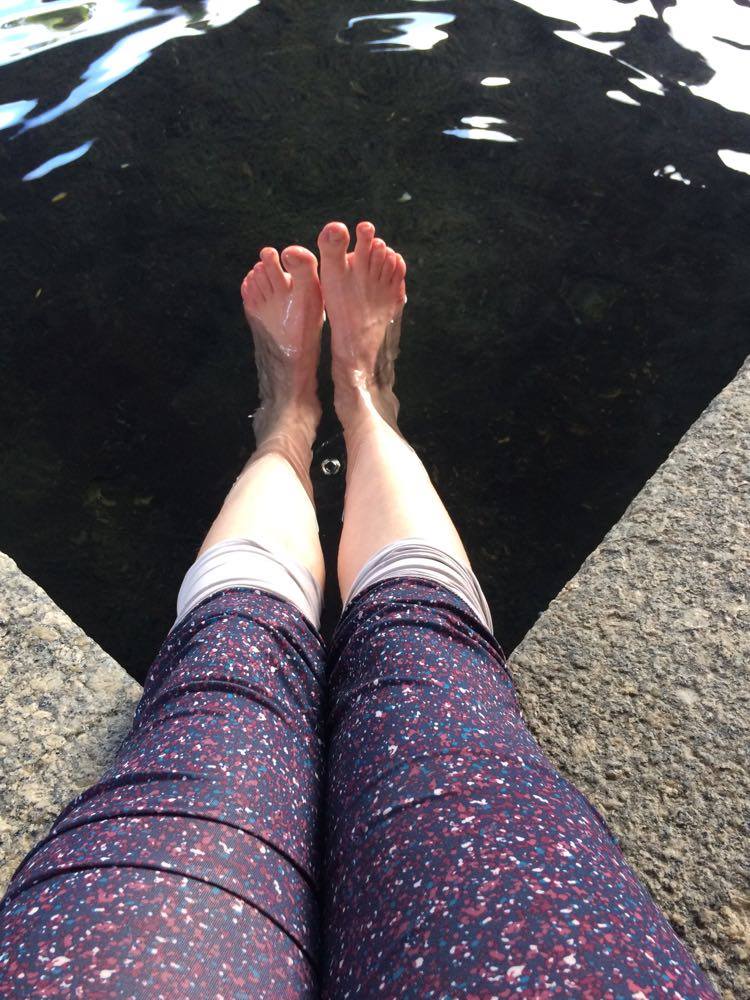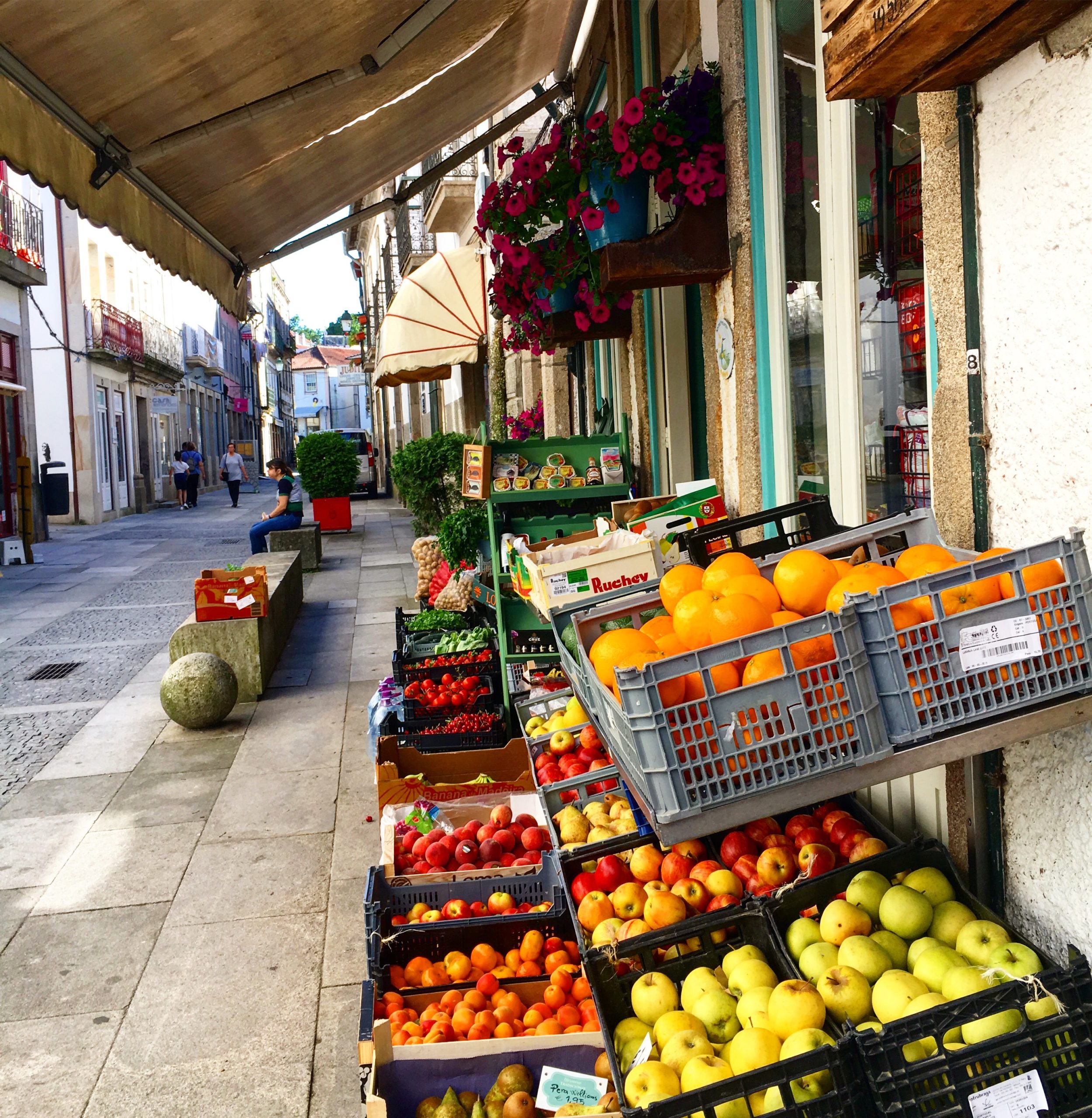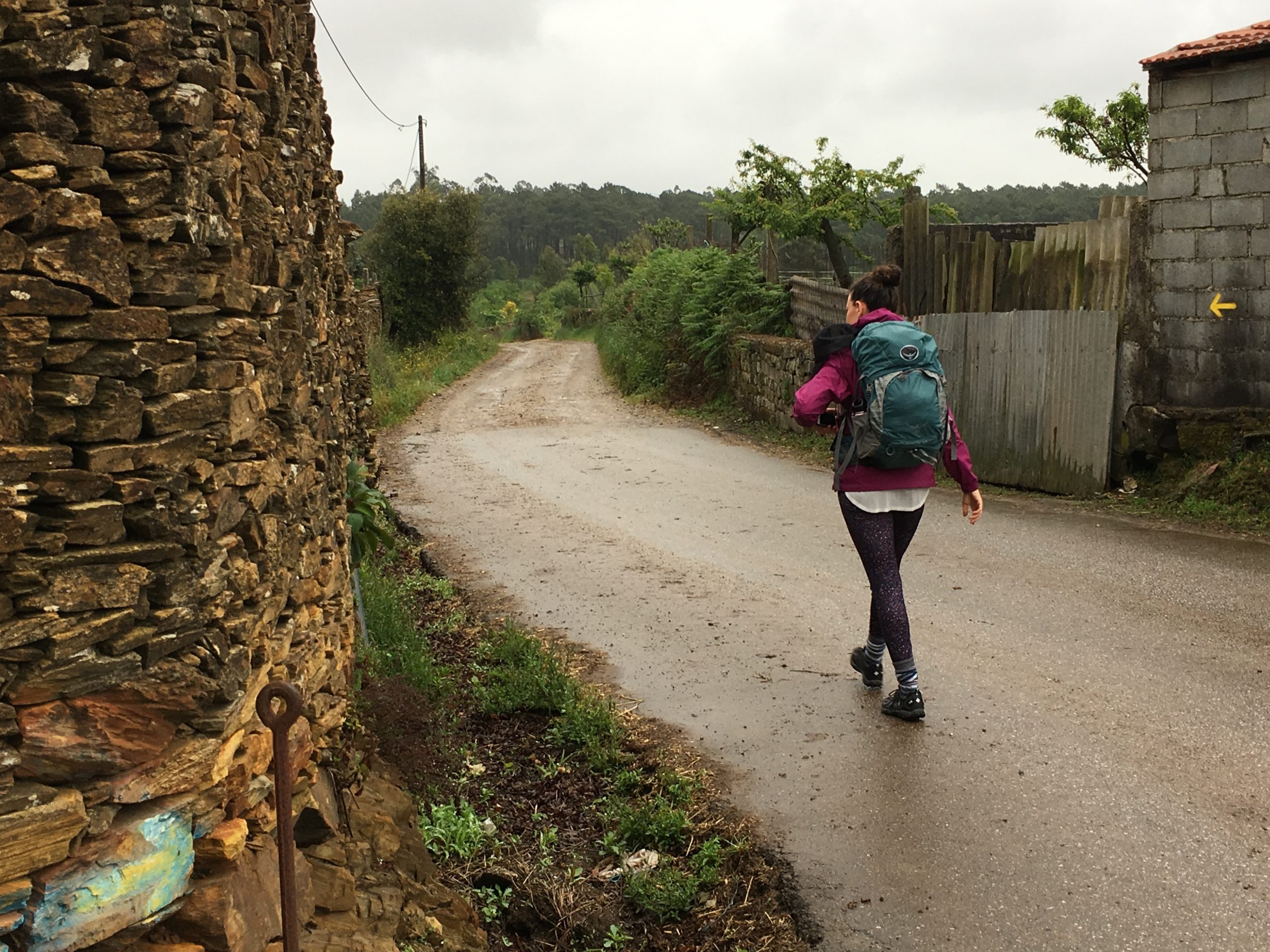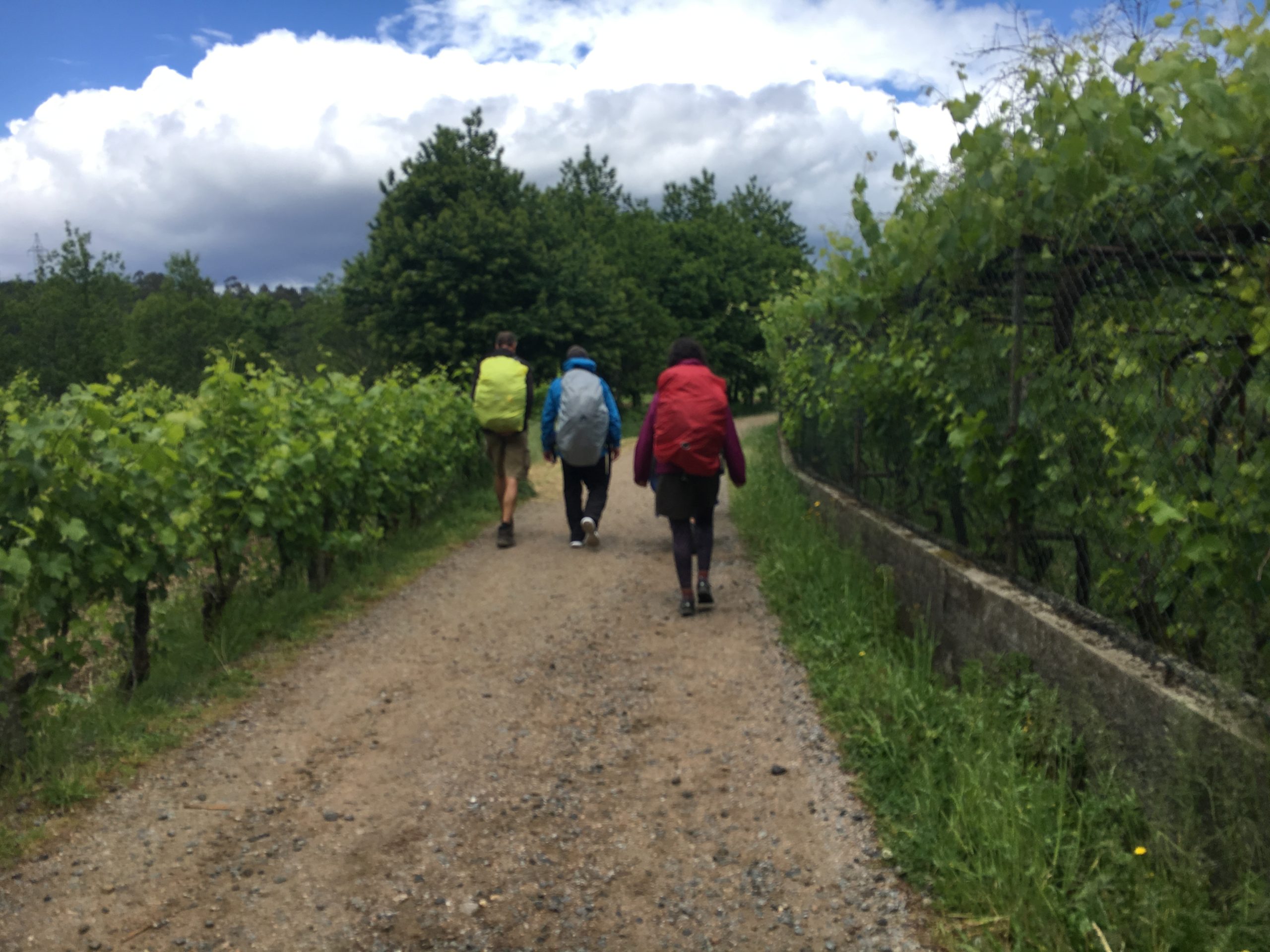
Camino Day 10 – Pontevedra to Caldas des Reies
7.5 hours walking, 28.5 km walked
(Walking times include stops for meals and breaks)
With a room to ourselves, we got a pretty good sleep, and luxuriated a bit in the morning quiet before getting on the road. The Camino winds through Pontevedra for the first part of the morning, so we got to see even more of this lovely city, including a quick walk past the Capela de Peregrina, which we’d visited the night before, through mostly-empty streets (with a few revelers from the night before still hanging out), preparations for a national literary festival, past a replica Roman milestone and the excavations of the Roman foundations of the original bridge and over the ponte which gives the town its name.
We made a brief and unmemorable stop at Bar El Estadio, just after the POnte de Burgo, to get a coffee and some breakfast – because this was a national holiday, a lot of places were closed, something that would have been great to know in advance – it’s always a good idea to be aware of upcoming holidays fo the country you’re travelling in!
On the road out of Pontevedra, there are plenty of drinking water fountains, interesting architecture, and Camino markers, and the weather was beautiful. As you can see, a full night’s sleep in a private room made a huge difference in our energy level!
The municipal albergues are great in so many ways, and as a budget-friendly accommodation they can’t be beat, but if you can afford a little more per night, I’d recommend staying in one or two of the municipal albergues for the experience and reserving spots in smaller for-profit albergues or other inexpensive accoms for the rest of your pilgrimage. Unless you’re the kind of person who can sleep through anything, you’re not going to get enough sleep in the municipal albergues.
This day was a good one for cats and iconography – I just love those two saints giving the universal hand gesture for ‘whoa, man!’ I mean, probably they’re amazed at beholding the wonders of God, but I also enjoy my own interpretation.
The walking in the morning was mostly forest, ivy-covered and ancient, along old paths.
Around 11am, we spotted A Pousada do Peregrino and decided to stop for a break. As we piled into the line with a crowd of other pilgrims, Sammi was lucky enough to snag the last piece of cheesecake and a glass of delicious fresh-squeezed orange juice, while I grabbed a cheese-and-tomato sandwich and a Meiga beer. I don’t normally drink that early in the day, but as we often said, we needed the extra calories for the walking. This was a great place to stop, eat, and recharge, and the cheesecake was excellent!
It looks like they’ve been undergoing renovations over the Winter, and were just about to reopen when the pandemic hit, so sadly the scrolls with spells and other pilgrim/folklore decor is probably gone. But I’m sure the food will be just as good.
When we stopped to refill our canteens, this gentleman was waiting behind us. As we left, he said this spring is ‘agua milagrosa,’ and we agreed.
It’s always a good sign when local people are stopping at a roadside spring to fill up jugs, just like back home.
Our beautiful day turned a bit moody, alternating between rain and sunny skies.
By this time we were ready for another bite to eat, so we made a quick stop in a very busy traditional style restaurant, which you can see a photo of above, incuding soup bowls of win on the tables. Realizing that the wait to get a seat was going to eat too much into our walking time, and hoping to get into the municiple albergue, we went on to O Cuberto, a very modern-looking and welcoming cafe with sandwiches, salads, coffee, and great staff.
Moving out of the country and into the the fringes of Caldas des Reyes, you get a real sense of a city that that’s very much Galician – we’d seen some ‘Glicia is not Spain’ graffitti throughout our route, but more of it started to pop up here. Caldas des Reyes has been a resort town since the roman period, when its natural hot springs made it a destination for the rich, and thoughout the intervening millennia, that’s continued to be the major draw. However, if the architecture is anything to go by, the last big surge of people coming to ‘take the waters’ was in the ifrs quarter of the 20th century, and it’s been a bit on the decline since.
When you arrive in the centre of the city, a first stop for many pilgrims, including us, is the Fuente termal de las Burgas. This is one of the places (and the most obvious, easy-to-find place) that the hot springs are publicly accessible, with water gushing at about 40 C into a small pool. When you arrive, you’ll find a small crowd of pilgrims pulling off their socks and shoes and plunging their feet in for a soak in the very, very hot water. Whether it’s just the heat, or some mineral properties of the water, Sammi and I both found it incredibly soothing, and it’s a lovely ritual after so many days working your feet and legs along the Camino.
We may have made a mistake in stopping at the hot spring before getting to the albergue, though it was already almost 4pm and we had been running a bit late all day. By the time we got there, they were all full up for the night. With no desire to walk any further that day, and feeling we started looking for places, finally settling on Select Real Apartments, right in the centre of town. This was a serviceable spot for the night, somehow both looking exactly like the photos and also not at all what we’d expected from the photos. But the host was extremely welcoming, and gave us lots of ideas for what to do that evening.
Because it was Galician Literature Day, many shops and restaurants were closed, so we had a bit of difficulty finding a place with vegetarian options for dinner. We stopped at a bakery for pastries, and fueled by those decided to explore the city while we still had the light.
We visited Igrexa de San Tomé Becket, the church dedicated to the English St. Tomas a Becket, the Archbishop of Canterbury who was martyred after King Henry II of England asked “will no one rid me of this turbulent priest?”
I’m not sure why there’s a shrine to him in Spain, but St. Thomas did make the pilgrimage to Santiago in 1167, three years before his death, so maybe he also made a stop at Caldas des Reies for the healing waters.
The statues in this church are lovely, and full of old friends, like St. Lucy, one of my favourites and clearly a favourite in Portugal and Spain as well – she was one of the Early Martyrs (if you read her legend, she, like many of the early Christian virgin martyrs was basically killed by toxic masculinity), and she’s very easy to spot because she always carries her eyeballs on a plate (sometimes easy to confuse with St. Agatha, who carries her breasts on a plate. I am not making that up). Our guy San Roque is, of course, the patron saint of Caldas des Reis, so he makes an appearance, and my favourite – the lake of fire, a very popular image in Spain and Portugal.
We took a walk down to the botanical gardens, full of unusual species of trees, and beautiful shady spots along the river.
On a tip from a local, we headed down to the Lavadero, where other pilgrims were gathered to soak their feet and enjoy the warm water – it’s not quite as hot as the hot spring, but it is warm as bath water, and the angled edges, designed for woman to scrub their washing, make a good perch.
We decided to go back to the hot spring for another quick soak, since it had felt so good, and had relieved our foot/leg pain so much. When we got there it was deserted. So we stuck our feet in, and were having a nice moment, when a local guy started yelling at us in Spanish, very peeved, and then another local person intervened – I still have no idea what that was about, but I’ve heard mixed things about whether or not its permitted for people to put their feet in the waters here (though it is clearly a long-standing tradition). This left us both feeling pretty bummed, a feeling we had a hard time shaking that evening. We grabbed a quick and insufficient dinner, and headed back to the apartment, hoping a good night’s sleep would shake off the downer of the angry man.
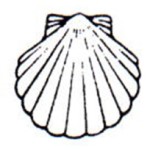
Follow our Caminho Portugues adventure!
Landing Day in Porto
Day 1 – Porto to Vila Cha
Day 2 – Vila Cha to Rates
Day 3 – Rates to Barcelos
Day 4 – Barcelos to Ponte de Lima
Day 5 – Ponte de Lima to Rubiaes
Day 6 – Rubiaes to Tui
Day 7 – Tui to Porriño
Day 8 – Porrino to Redondela
Day 9 – Redondela to Pontevedra
Day 10 – Pontevedra to Caldas des Reies (you are here)
Day 11 – Caldas des Reies to Padrón
When I’m done posting these, I’ll also post an article with my collected advice for anyone thinking of walking the Caminho/Camino, and I’ll link it here!
Photos by Candace Shaw and Samantha Shaw
